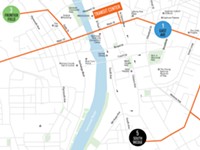[
{
"name": "500x250 Ad",
"insertPoint": "5",
"component": "15667920",
"parentWrapperClass": "",
"requiredCountToDisplay": "1"
}
]
When students talk about the high cost of education today, they're likely to be talking about a lot more than tuition, room and board. The average college student now also carries more than four credit cards with balances totaling $2,327.
In upstate New York alone, college students have racked up nearly $775 million in credit card debt, according to a 2005 study released by Senator Charles Schumer, who is sponsoring a bill to promote responsible credit practices among college students. Schumer proposes clearer disclosure from credit card companies, advance knowledge of rate hikes, parental consent and bill notification for dependent students.
According to a study done by nationwide student loan center Nellie Mae:
-Almost all second-year college students have a credit card, compared with only half (54 percent) of entering freshmen.
-Half (47 percent) of students with credit cards have at least four of them.
-The amount of debt a student carries on his or her credit card more than doubles between the first and fourth year of college. The average credit card debt level for a first-year student is $1,533, which escalates to $1,825 in the second year, $2,705 in the third year and $3,262 in the fourth year.
-One-fifth (21 percent) of credit card-holding seniors carry debt from $3,000 to $7,000.
The numbers are staggering. In Central New York alone, students carry $100 million worth of debt when they graduate, according to Schumer's study. Students in the Rochester/Finger Lakes area carry $149 million worth of debt, while those in the North Country have $52 million worth of debt.
It's no wonder, considering how easy it is for students to get credit. Credit card companies set up recruitment tables on campuses. Offers are stuffed into new textbooks, delivered to students' physical and electronic mailboxes, and posted on campus bulletin boards. "Companies seize almost any opportunity to recruit new borrowers, especially 18- to-24-year-olds who make small purchases that are likely to add up unnoticed," notes Schumer. "This demographic is also the least likely to be able to pay off their monthly balance in full, racking up high finance charges."
The best approach for college students is to have just one card with a lower credit limit and know that you have income enough to pay the monthly bill, according to Frank Polera, assistant director of community relations with Consumer Credit Counseling Service of Central New York.
"If you're not working and don't have an income coming in, then it is difficult to pay it. You just have to know what your limits are, set up a budget and work from that budget. You're going to have to do it once you get out of college," says Polera, whose company's services include free advice and counseling.
It's not necessarily a bad thing to have a credit card, especially as students will need to establish a credit history, Polera says. But the key is to know what the repercussions could be if it isn't used wisely.
Among the pitfalls to watch out for, according to Schumer:
-Low annual percentage rates don't stay low for long. A card's rate could more than triple in seven months. The Public Interest Research Group found that on average after 6.9 months rates shot up by 264 percent.
-If you pay your bill late just once, you could face late fees of up to $39, and your annual percentage rate could spike to 25 percent. Nellie Mae reports that students are far more likely to pay their bills late than adult cardholders.
-If you go over your limit, it'll cost you up to $35. According to Michael Staten, director of the McDonough School of Business at GeorgetownUniversity, students also have a stronger likelihood of going over their credit limits and carrying balances that exceed their credit limits more often then their adult counterparts. PIRG research shows that some credit card companies will charge overage fines of up to $35 for customers who exceed their limits by even $1.
The average $2,300 student credit card debt load can escalate if payment is not made on time and late fees and higher interest rates that kick in start to compound. Even just minimum monthly payments don't make much of a dent in one's debt. For example: making just the minimum payment of $81 on a $3,262 credit card debt could take more than 22 years to pay off --- assuming that the card holder never charges another thing and that the interest rate remains at 18 percent. In the end, the cardholder will have paid more interest on the debt than the amount originally charged.
And getting a card revoked for non-payment could be the least of a student's problems. Some employers look at a job candidate's credit report, as do some apartment managers, before making a decision. "Some students rack up so much debt that at the end of their college career they end up facing bankruptcy. That's an extreme case, but if you start out with bad credit it just ends up changing that," Polera says. "A lot of students get the card for an emergency, but then you find you're a little short next week and it really starts to grow and grow and grow. And if you don't have a job or a way to pay for it, it racks up even more."
Credit where credit is due
Tips for using credit cards wisely
-Find a card with no annual fee and a limit of no more than $500
-Stay below your limit
-Always pay on time
-Make sure you understand the credit card terms, including late fees and extra charges
-Keep your personal information to yourself to help eliminate the possibility of ID theft and unexpected charges











